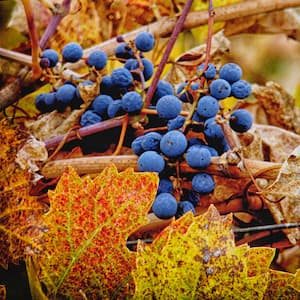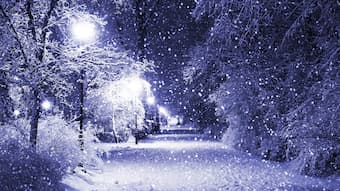
© Pixels
Although Spring may be the concerto that most people are familiar with, it’s Autumn and its return to a major key that seems to be central to The Four Seasons. The fear and frights of Summer disappear with the appearance of the harvest.
What’s also interesting here is how Vivaldi breaks the sonnet. Up to this point, the first 8 lines illustrate the first movement, the next 3 are used for the second movement, and the last 3 become the core of the third movement. Now, he breaks the 14 lines as 4+2+8.
We open with a simple repeated dance tune before the violin takes off as the soloist. Now the wine makes the violin positively loquacious, alternatively energetic and languishing.
Allegro
The peasant celebrates with songs and dances
the pleasure of a bountiful harvest.
And fired up by Bacchus’s liquor,
many end their revelry in sleep.
Antonio Vivaldi: The Four Seasons – Violin Concerto in F Major, Op. 8, No. 3, RV 293, “L’autunno” (Autumn) – I. Allegro (Rainer Kassmaul, violin; Berlin Baroque Soloists; Rainer Kassmaul, cond.)
In the second movement, everyone has fallen asleep – so much to eat and drink and so much to celebrate that a little nap won’t go amiss.
Adagio molto
Everyone is made to forget their cares and made to sing and dance
By the air which is tempered with pleasure
And (by) the season that invites so many, many
Out of sweetest slumber to blissful enjoyment.
Antonio Vivaldi: The Four Seasons – Violin Concerto in F Major, Op. 8, No. 3, RV 293, “L’autunno” (Autumn) – II. Adagio molto (Rainer Kassmaul, violin; Berlin Baroque Soloists; Rainer Kassmaul, cond.)
For the final movement, we have the other kind of autumn harvest – the hunters on the trail of a wild beast. The hounds chase, the beast stands at bay, he escapes again, and the chase leads on. It’s all to no avail, the hunters are triumphant and in a sad minor ending, the beast dies and then everyone celebrates.
Allegro
The hunters emerge at the new dawn,
And with horns and dogs and guns depart upon their hunting.
The wild beast flees and they follow its trail;
Terrified and tired by the great noise
of guns and dogs, the wounded beast,
tries futilely to flee, but harried, dies.
Antonio Vivaldi: The Four Seasons – Violin Concerto in F Major, Op. 8, No. 3, RV 293, “L’autunno” (Autumn) – III. Allegro (Rainer Kassmaul, violin; Berlin Baroque Soloists; Rainer Kassmaul, cond.)

© scotchwhisky.com
This Autumn is as we expect it – feasting and hunting, yet with some commentary in the setting. There’s so much that one can’t help but eat everything, but was it really necessary to go hunting in the end? After man’s fear of nature in the summer, nature comes to fear man in the autumn.
Most views of winter in art are from the inside – the warm fire, the snoozing dog, the idea of comfort in a harsh world – but Vivaldi pitches us outside into the snow. We shiver, we shake, and stamp and run to keep the blood moving and the warmth circulating. Vivaldi has caught the speed of the wind and the vibration of our chattering teeth perfectly.
Allegro non molto
To tremble from cold in the icy snow,
In the harsh breath of a horrid wind;
To run, stamping one’s feet every moment,
Teeth chattering in the extreme cold.
Antonio Vivaldi: The Four Seasons – Violin Concerto in F Minor, Op. 8, No. 4, RV 297, “L’inverno” (Winter) – I. Allegro non molto (Gidon Kremer, violin; London Symphony Orchestra; Claudio Abbado, cond.)
Now we’re inside, and outside it rains, or is that the icicles dripping off the house?
Largo
Before the fire to pass peaceful, contented days
while the rain outside pours down.
Antonio Vivaldi: The Four Seasons – Violin Concerto in F Minor, Op. 8, No. 4, RV 297, “L’inverno” (Winter) – II. Largo (Gidon Kremer, violin; London Symphony Orchestra; Claudio Abbado, cond.)
This is one place where I think this recording gets it wrong – the tempo is too fast for the ideas in the poetry. Listen to it again at a slower tempo and see if you agree.
Antonio Vivaldi: The Four Seasons – Violin Concerto in F Minor, Op. 8, No. 4, RV 297, “L’inverno” (Winter) – II. Largo (Takako Nishizaki, violin; Capella Istropolitana; Stephen Gunzenhauser, cond.)
Back outside we go. We start carefully, ever step carefully examined, and then the mistake, we turn and boom, crash on the ground. Getting up again, we know the worst that can happen and we’re less careful, rushing more and trying to get home. Are we miserable at the cold and the falls and the constant shivering? No, this is winter and that’s why we’re outside and sliding.
Allegro
We tread the icy path slowly and cautiously,
for fear of tripping and falling.
Then turn abruptly, slip, crash on the ground,
And rising, hasten on across the ice in case it cracks.
We feel the chill north winds course through the home
despite its locked and bolted doors…
This is winter, which, nevertheless,
brings its own delights.
Antonio Vivaldi: The Four Seasons – Violin Concerto in F Minor, Op. 8, No. 4, RV 297, “L’inverno” (Winter) – III. Presto (Gidon Kremer, violin; London Symphony Orchestra; Claudio Abbado, cond.)

© EskiPaper.com
Just as in Autumn, Vivaldi breaks the sonnet into 4+2+8; this permits him to keep the extreme of the middle verse separate. Vivaldi’s use of the concerto form with its contrasting slow movement has been used to great skill through the entire concerto set – sometimes we’re lying in the sun, sometimes lying in fear of the weather, sometimes asleep after a surfeit of sustenance, and, in the case of winter, we’re inside warming up so that we can go outside again!
Vivaldi wasn’t the first to write about the seasons, there were many antecedents, such as Christopher Simpson’s four fantasia-suites The Seasons, Jean-Baptiste Lully’s Ballet des Saisons (1661), Henry Purcell’s frost scene in Act III of King Arthur (1691) and his ‘Masque of the Seasons’ in Act IV of The Fairy-Queen (1692), Pascal Collasse’s Ballet des saisons (1695), Johann Caspar Fischer’s Journal du Printemps (1695), and Johann Abraham Schmierer’s Zodiaci Musici (1698). In those works, which are very different from Vivaldi’s concept, we do see similarities in the use of musical figures for the winds and shivering. However, it is Vivaldi’s work that brings the seasons home to us so clearly. We can sympathise with the poet protagonist as he goes through the year – we know what it is to fall asleep in the sun and to slip on a piece of icy ground. We see ourselves in each of the pieces and this has helped to make these works such favourites.
For more of the best in classical music, sign up to our E-Newsletter




